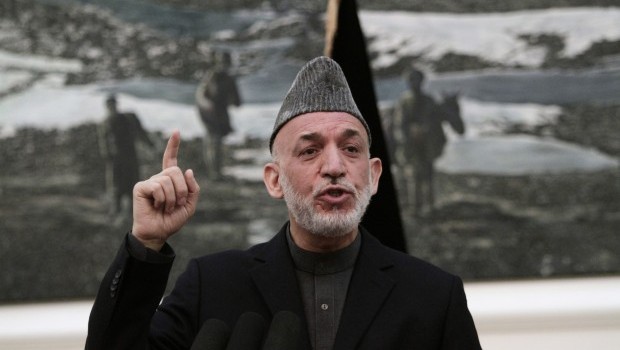This week, Afghans started registering for their next presidential election in an atmosphere that could hardly be described as enthusiastic. The prospects of the election are the subject of great speculation. Some doubt it will actually take place. Others fear the incumbent, President Hamid Karzai, will use devious schemes to prolong his tenure, rendering the exercise redundant.
The US-led NATO powers want the exercise to go ahead because it could provide the cover they need for the withdrawal by the end of 2014. If the election takes place in April, as scheduled, the new president could have his administration in place by June. That would give NATO six months to pack up and go.
The real question, however, is whether the presidential system imposed by Washington after the expulsion of the Taliban from Kabul in 2001 can work in Afghanistan.
Karzai’s decade-long tenure provides few clues. Few Afghans saw him as a president in the normal sense of the term. Instead, they saw him through the prism of Afghan political culture as a man backed by the most powerful tribe capable of imposing its rule on the country. In this case, the “most powerful tribe” was the 120,000-man NATO army.
In Afghan political culture, a ruler derives legitimacy from his tribe’s ability to achieve “domination” (sultah). Thus, if the NATO “tribe” is no longer there to ensure sultah, there would be no reason to grant legitimacy to whomever becomes president next year.
In 2002, as the US-led coalition debated Afghanistan’s post-Taliban political system, some of us believed that exporting the American presidential system was a mistake. Afghanistan had always been a loose federation of 18 ethnic and religious communities acknowledging the symbolic authority of a king in Kabul. Although a strong sense of “Afghan-ness” existed among all communities and tribes, there was no desire for a centralized government.
One reason for the failure of the Communists who seized power in Kabul in 1978 was the imposition of a centralized government with a president exercising exclusive executive power.
Before Afghanistan, the US had exported its presidential system to a number of other countries, often with unhappy results. In the Philippines, the US-imposed presidential system led to decades of dictatorship. A similar experience in Cuba produced Battista’s despotism, followed by the despotism of the Castro brothers. In South Korea, the presidential system led to five decades of authoritarian rule backed by the military.
By 2002, experience had already shown that as far as pre-democratic societies were concerned, a presidential system was a recipe for dictatorship.
In contrast, where the Americans took the native political culture into account, the result was speedy democratization. That is what happened in Federal Germany and Japan. In both cases, a parliamentary system of government was favored over a presidential one.
The experience of decolonization in the 1940s to 1960s produced similar results. The French exported the presidential system to their former colonies, only to witness the emergence of dictators in most newly-independent nations.
In contrast, the British exported their parliamentary system to former colonies. In most cases, the result was slow but steady democratization. One need not mention Canada, Australia and New Zealand, which could be regarded as parts of the cultural “Anglosphere.” India also became a democracy, at least partly thanks to the parliamentary system. Neighboring Pakistan opted for the presidential system and, its democratic prospects always in doubt, experienced long periods of military rule.
A more recent example is that of Iraq after the toppling of Saddam Hussein. The Iraqis rejected an American presidential system. Instead, they opted for a British-style parliamentary system. Iraq has not yet become a stable democracy and still faces the threat of reverting to despotic rule. However, it has managed to change governments through elections on three occasions and, despite many zigzags, remains on the path of democratization.
In contrast, the attempt to impose a presidential system on post-Mubarak Egypt has led to a coup against the nation’s first freely elected president and a crisis with unforeseeable consequences. Once again, we see that in pre-democratic societies, a presidential system can only be maintained through the use of force. A president who cannot crush his opponents in the streets is unlikely to last long. And to do so, he would need the armed forces. That, in turn, means military rule regardless of who plays the role of the president.
A parliamentary system provides greater scope for power-sharing, compromise and rotation of personnel when required. Had Muhammad Mursi been prime minister rather than president, the parliament—or even his own party—could have replaced him with a more consensual figure. As president, however, there was no legal or political mechanism for his removal before the end of his term. The only way to remove him was a coup.
Let us return to Afghanistan. One reason for the ultimate failure of the Taliban was their attempt at imposing their own version of the presidential system with Mullah Muhammad Omar cast as Emir Al-Mu’meneen (Commander of the Faithful) with exclusive executive power.
After NATO leaves, the Afghan national army will be in no position to play the dominant tribe needed to maintain a president in power.
The best option for Afghanistan is to amend the US-imposed constitution to replace the presidential system with a parliamentary one. A parliamentary system would allow the nation’s various communities to come together through coalition-building and power-sharing.
Instead of a presidential election, Afghans would do better to draft a new constitution and hold a referendum to get it approved by the people.
